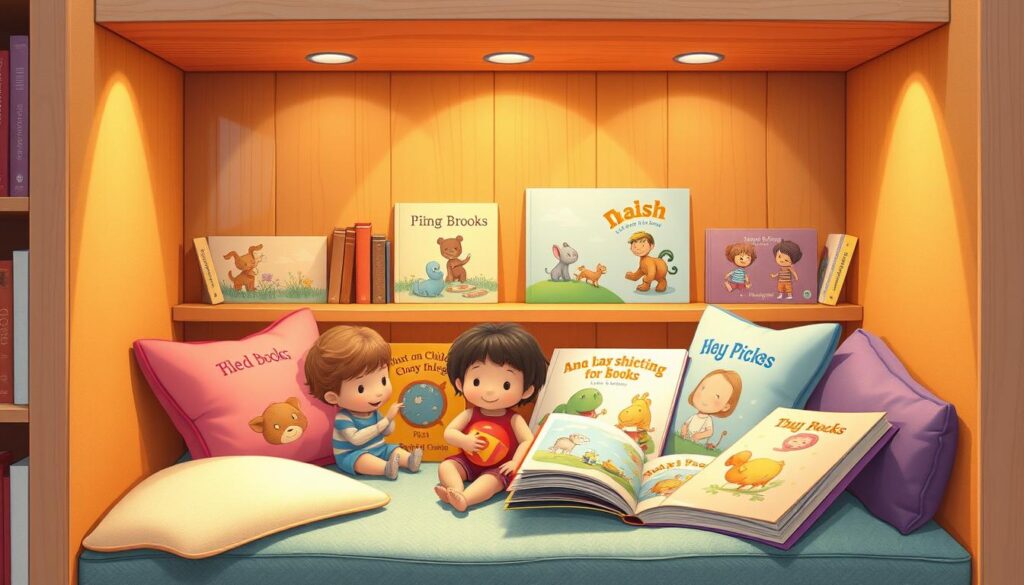Have you ever watched a child become completely absorbed in a book, not just looking at the pictures, but engaging with the story on a deeper level? As a parent, I’ve seen firsthand how interactive children’s books can captivate young minds, transforming reading into an immersive experience.
For children who struggle to sit still or focus on traditional reading, these books with interactive elements can be a game-changer. They create a magical connection between the child and the story, making reading a delightful adventure. Whether you’re traveling, waiting in a doctor’s office, or just need a quiet moment, these books can be incredibly valuable.
In this article, we’ll explore why interactive elements in children’s stories matter and how you can use them to foster a love of reading in your child.
The Evolution of Children’s Books in the Digital Age
The digital revolution has changed the landscape of children’s literature, making it more interactive. As a result, children’s books are no longer just about reading; they’re about experiencing a story in a whole new way.
From Traditional to Interactive Storytelling
Traditional children’s books have given way to interactive books that engage young readers in a more immersive experience. With features like flaps to lift, buttons to press, and puzzles to solve, these books encourage children to participate actively in the storytelling process. Research shows that such interactive elements can significantly enhance a child’s learning experience.
Meeting Modern Children’s Engagement Needs
Children growing up in today’s digital world have different expectations when it comes to engagement. Interactive children’s books satisfy this need by providing immediate feedback and participation. By bridging the gap between screen time and traditional reading, these books offer a unique reading experience. Studies have shown that interactive elements help maintain a child’s focus and can be particularly beneficial for children with different learning styles.
What Makes Interactive Elements in Kids’ Stories Special
As a parent, I’ve seen firsthand how interactive elements can transform storytime into an immersive experience. Interactive children’s books are not just entertaining; they’re a gateway to a more engaging and effective way of storytelling.
Types of Interactive Features in Children’s Books
Interactive children’s books come in a variety of formats, each offering unique ways to engage young readers. Some common types of interactive features include:
- Pop-up elements that bring stories to life
- Flaps that hide and reveal surprises
- Pull-out tabs that encourage children to participate
- Sound-emitting pages that enhance the narrative
How Interactivity Transforms the Reading Experience
Interactive elements transform passive reading into an active, engaging experience. By incorporating interactivity, children develop a deeper emotional connection to the story and characters. This connection helps them better understand cause and effect relationships and makes abstract concepts more concrete.
Moreover, interactive books create a shared reading experience that strengthens bonds between children and adults. The element of surprise and discovery keeps children engaged and excited about reading, fostering a love for books that can last a lifetime.
5 Developmental Benefits of Interactive Storytelling
Beyond mere entertainment, interactive storytelling plays a crucial role in child development. Interactive books are designed to engage children on multiple levels, enhancing their cognitive, motor, and emotional skills. As we explore the benefits of interactive storytelling, it’s clear that these books offer more than just a fun reading experience.
Enhancing Literacy and Language Skills
Interactive storytelling significantly contributes to improving literacy and language skills in children. By engaging with interactive elements, children are encouraged to read, comprehend, and respond to the story, thereby enhancing their vocabulary and understanding of language structures. You can explore more interactive stories that foster this development.
Developing Fine Motor Skills and Coordination
The interactive features in these books, such as flaps, buttons, and pull-outs, help develop fine motor skills and hand-eye coordination. As children manipulate these elements, they improve their dexterity and coordination, essential for overall physical development.

Fostering Problem-Solving Abilities
Interactive stories often present children with challenges or puzzles to solve, thereby fostering problem-solving abilities. This interactive engagement encourages critical thinking and analytical skills, preparing children for more complex challenges as they grow.
Building Attention Span and Focus
The engaging nature of interactive books helps build attention span and focus in children. As they become more invested in the story and its interactive elements, they learn to concentrate and follow through with the narrative.
Encouraging Parent-Child Bonding
Interactive reading creates a shared experience between parent and child, encouraging bonding through mutual engagement and enjoyment. This shared activity fosters a positive association with reading and strengthens the parent-child relationship, creating lasting memories.
In conclusion, interactive storytelling offers a multifaceted approach to child development, enhancing a range of essential skills while making reading a enjoyable and engaging experience. By incorporating interactive elements, these stories provide a way to captivate young minds and support their overall growth.
10 Must-Have Interactive Books for Your Child’s Library

Building a library of interactive books can be a game-changer for your child’s reading journey. Interactive books have the power to captivate young minds, foster a love for reading, and create a fun and engaging experience. In this section, we’ll explore some of the best interactive books for children of different ages.
For Toddlers (Ages 0-3)
Toddlers love to explore and interact with their surroundings, making interactive books a perfect fit. Here are some top picks for this age group:
Press Here by Hervé Tullet
Press Here is a simple yet captivating children’s book that encourages young readers to interact with the story. The book features a series of colorful dots that appear on each page, and as the reader follows the instructions to “press here” or “shake the book,” the dots change in size, color, and pattern.
Tap the Magic Tree by Christie Matheson
Tap the Magic Tree is another interactive delight that invites children to tap, touch, and explore the story. With its simple and repetitive text, this book is perfect for toddlers who are just beginning to discover the magic of interactive reading.
Don’t Push the Button! by Bill Cotter
Don’t Push the Button! is a fun and interactive book that teaches children about cause and effect. With its colorful illustrations and engaging text, this book is sure to delight toddlers and encourage them to interact with the story.
For Preschoolers (Ages 3-5)
Preschoolers are naturally curious, and interactive books can help foster their creativity and love for reading. Here are some top picks for this age group:
The Monster at the End of This Book by Jon Stone
The Monster at the End of This Book is a beloved classic children’s book that has been delighting young readers for decades. Starring Sesame Street’s lovable and furry blue monster, Grover, the book takes a fun and interactive approach to storytelling.
This Book Just Ate My Dog! by Richard Byrne
This Book Just Ate My Dog! is a humorous and interactive book that follows the adventures of a dog who gets eaten by the book itself. With its playful text and engaging illustrations, this book is sure to captivate preschoolers.
High Five by Adam Rubin
High Five is a fun and interactive book that encourages children to participate in the storytelling process. With its simple and repetitive text, this book is perfect for preschoolers who are just beginning to develop their reading skills.
For Early Elementary (Ages 6-8)
Early elementary school children are developing their reading skills and can engage with more complex interactive books. Here are some top picks for this age group:
The Book With No Pictures by B.J. Novak
The Book With No Pictures is a unique and interactive book that requires readers to make sounds and noises to bring the story to life. With its engaging text and interactive elements, this book is perfect for early elementary school children.
The Jolly Postman by Allan and Janet Ahlberg
The Jolly Postman is a classic interactive book that allows children to engage with the story by opening envelopes and reading letters. With its clever text and engaging illustrations, this book is sure to delight early elementary school children.
Adventures in Cartooning by James Sturm
Adventures in Cartooning is an interactive book that teaches children the basics of cartooning and storytelling. With its engaging text and interactive elements, this book is perfect for early elementary school children who are interested in art and creativity.
Mix It Up! by Hervé Tullet
Mix It Up! is another interactive book by Hervé Tullet that encourages children to experiment with color mixing and art. With its simple and engaging text, this book is perfect for early elementary school children who are developing their creativity and fine motor skills.
For more interactive stories and learning resources, visit https://lunesia.app/interactive-stories-for-learning/ to discover a world of engaging and interactive content for your child.
How to Make the Most of Interactive Reading Sessions
To truly leverage the potential of interactive books, it’s essential to understand how to optimize your reading sessions. Interactive reading can be a powerful tool for engaging your child and fostering a love for reading.
Creating a Comfortable Reading Environment
First, create a comfortable reading environment that invites your child to engage with the book. This could mean setting up a cozy reading nook or simply ensuring that the reading area is well-lit and free from distractions.
Following Your Child’s Lead and Interests
It’s also crucial to follow your child’s lead and interests during interactive reading sessions. Allow them to guide the pace and explore the story in their own way. This not only makes the experience more enjoyable but also helps in developing their problem-solving skills.
Extending the Interactive Experience Beyond the Book
To further enhance the experience, consider extending the interactive elements beyond the book itself. For example, you can create real-world connections to the concepts in the story or use the interactive techniques in everyday conversations and play.
| Activity | Description | Benefit |
|---|---|---|
| Real-world connections | Linking story concepts to real-life situations | Enhances understanding and retention |
| Interactive play | Using story elements in play activities | Fosters creativity and engagement |
| Conversational storytelling | Incorporating story themes into daily conversations | Develops language skills and bonding |
Conclusion: Embracing the Interactive Reading Journey
The journey through interactive children’s literature reveals a world where reading is not just about turning pages, but about experiencing a story come alive. Interactive books have the power to transform reading into an immersive experience, fostering a deeper connection between children and the story.
By incorporating interactive elements, these books enhance literacy, fine motor skills, and problem-solving abilities. They create joyful associations with reading, potentially turning reluctant readers into enthusiastic participants.
I encourage you to make interactive books a part of your regular reading routine, as they yield significant developmental benefits. Let’s embark on this interactive reading journey together, exploring the vast world of children’s literature!
FAQ
What are the benefits of interactive books for my child’s development?
Interactive books can enhance your child’s literacy and language skills, develop their fine motor skills and coordination, foster problem-solving abilities, build attention span and focus, and encourage parent-child bonding.
What age range are interactive books suitable for?
Interactive books are suitable for children from 0 to 8 years old, with different types of interactive features catering to various age ranges, such as board books for toddlers and more complex storylines for early elementary children.
How do I choose the right interactive book for my child?
Consider your child’s age, interests, and abilities when selecting an interactive book. Look for books with engaging illustrations, simple or complex storylines, and interactive features that align with your child’s developmental stage.
Can interactive books be used for reading aloud to my child?
Yes, interactive books are perfect for reading aloud to your child. They encourage a fun and engaging reading experience, allowing you to point to and identify different objects, animals, or characters, and to ask questions that stimulate your child’s imagination.
How can I make the most of our interactive reading sessions?
Create a comfortable reading environment, follow your child’s lead and interests, and extend the interactive experience beyond the book by incorporating related activities and discussions into your daily routine.
Are interactive books available in different formats, such as board books or e-books?
Yes, interactive books come in various formats, including board books, paperback, and e-books, allowing you to choose the format that best suits your child’s needs and your reading preferences.




